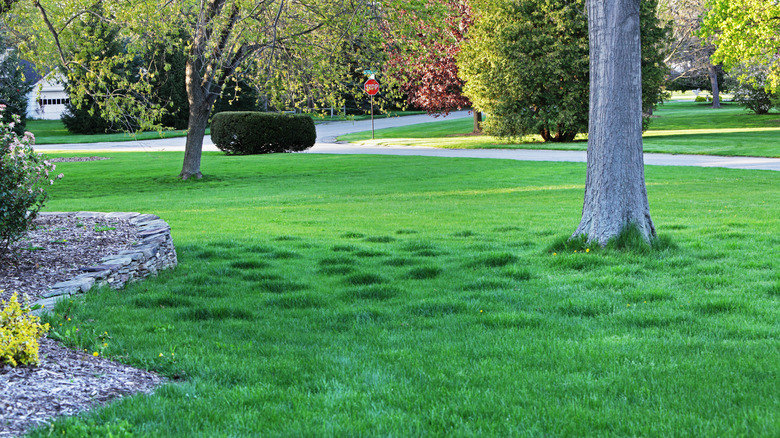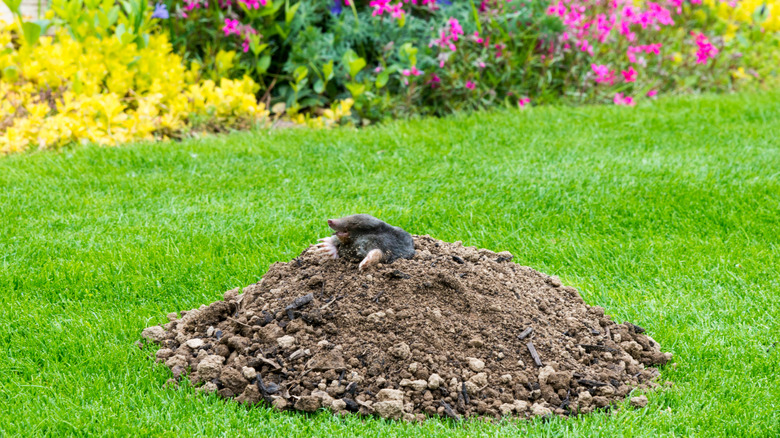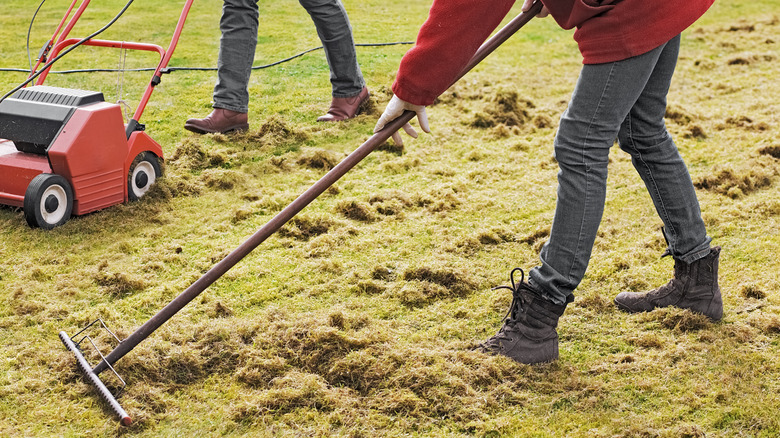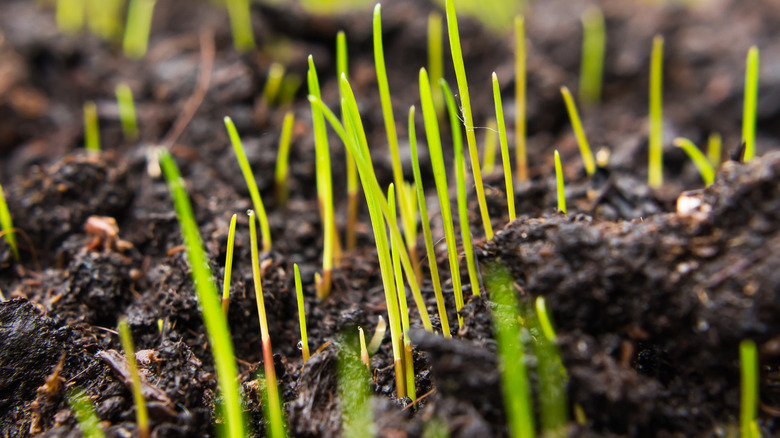Genius Tricks To Level Your Bumpy Lawn Without Heavy Equipment
Bumpy lawns are an absolute pain to deal with. It makes everything, from planting new garden beds to simply mowing the grass, more annoying. It can be a safety hazard when the kids are playing in the yard, and it turns a beautiful lawn into a bit of an eyesore. The most frustrating thing about bumpy lawns, though, is trying to fix them.
Taming Mother Nature is never easy. It's reasonable to assume you'll need to call in some heavy-duty equipment to straighten her out. But today, we're here to help you cancel your skid steer rental and level your lawn without heavy equipment. It's not always possible to level your lawn without some backup. There is no magic trick that will make it possible to re-grade your front yard or rip up an entire root system with your bare hands. Still, there are plenty of bumps and divots that can be smoothed out without renting equipment.
We've called on Ryan Farley, CEO of LawnStarter, to help us make it happen. LawnStarter has been built from the ground up with a core value to "be cheap" (according to an interview with Forbes). Sounds like there's no one better to talk to about getting leveling work done without bringing in tons of expensive equipment. Ryan will walk us through causes, signs, and solutions for rough-and-tumble lawns and help us smooth them out in no time.
What causes a bumpy lawn?
Before you start smoothing out your lawn, you've got to get to the root of your problems. Lawns don't just develop humps — something is making it happen. If we don't figure out what's creating our lumpy custard, we'll end up doing this all again next year. Luckily, The folks at LawnStarter have seen it all, and Ryan has noticed a few patterns.
The most common reason he sees bumpy lawns is the presence of burrowing pests, typically moles, gophers, rabbits, or even earthworms. "Over time their activities under your yard can cause the soil to become uneven," he shared. Another reason Ryan sees a lot of bumpy lawns is the repeated freezing and thawing of soil over the course of winter. Unfortunately, there's not a whole lot you can do to stop the weather, but if pests are causing your problem, you should get rid of them before attempting to level.
Water drainage issues are also a common problem that can lead to a bumpy lawn. Each lawn drains differently, and sometimes that can cause water to pool up in certain areas. Standing water will cause long-term damage to the soil and grass root systems that will lead to a bumpy-looking backyard. If pests, roots, or water drainage issues led to the predicament you're in, leveling out the lawn won't solve the problem on its own. Nip the issues in the bud before you level to avoid spending each spring shoveling out more sand.
Understand exactly when you should level your lawn
Gardening work is a lot about timing. If you level your lawn during your grass' peak growing cycle, you'll be able to do the job much easier — and without calling in the heavy equipment. Leveling your lawn isn't quite as rhythmic as planting patterns can be, but there are still right and wrong times to start ripping up your topsoil.
Leveling out your bumpy lawn requires tons (sometimes literally) of sand and topsoil. Your main focus is smoothing out divots, but you'll end up covering almost every inch of your lawn with your topsoil blend. If you coat your bumpy lawn in topsoil at a time when your grass isn't growing at its peak capacity, it might not be able to poke through your work, and you'll end up with a whole new problem on your hands. Springtime is usually a good bet for making crucial lawn care upgrades. The team at LawnStarter recommends leveling warm-season grasses in spring and cool-season grasses in late summer or early fall. Time your leveling with your grass' growth, and sprinkle on tons of overseed while you aerate and dethatch, and you'll be rewarded with a smooth and healthy-looking yard.
Aerate and dethatch in advance
There's no genius trick to level your bumpy lawn without heavy equipment that won't take some serious TLC. Says Ryan, "You can certainly DIY a lawn leveling, although it will take some time and hard work." So buckle up and break out the garden fork.
Thatch build-up is a common cause of bumpy lawns. Pests or water damage is the culprit behind your uneven garden, but those damages will reveal themselves as a layer of dead shoots, stems, and roots, also known as thatch. A thin layer of thatch is natural and can even be healthy for your root system, but when there is too much thatch build-up in certain parts of your lawn, it can decimate those sections and create uneven surfaces. While we're leveling, we might as well take care of every threat possible.
A dethatcher is the best tool for the job, but you can also dethatch using a leaf rake (although it may not be as effective). After you dethatch, use a garden fork or pitchfork to poke holes across your lawn. If you're dealing with sections of lawn that stick up higher than the rest, this is the step to level everything out. Stick the fork in any raised areas and move it back and forth to loosen up the soil and break down bumps. Regardless of what specific sections need leveling, you should aerate the entire lawn and generously apply a layer of overseed to help your soon-to-be level lawn grow an even layer of grass.
Fill in your lawn with a topdressing soil mixture
Creating the right blend of nutrients for your bumpy lawn will help you level it out without investing in any rolling equipment. Ryan and the team at LawnStarter recommend a healthy portion of equal parts sand, compost, and topsoil, all mixed up in a wheelbarrow. This blend is known as a topdressing, and it's all you need to smooth out a few bumps and divots in your yard. Grab a shovel and take your concoction out to your lawn to smooth it all over.
Take your mixture directly to any depressions first and completely fill them in. Once you've leveled out any holes, spread the rest of the mixture around your entire lawn with your shovel to make sure that all of your grass is getting the same nutrients. After it's laid down, smooth over your lawn with a rake or a lawn mower until everything is smooth and compact. Finally, water everything down and continue to level things out with your shovel during the watering process. You should water your lawn more than normal while your new grass seeds take root. Even though you shouldn't always water your lawn twice a day, in this case, overwatering is okay. LawnStarter specialists say it's best to water your lawn first thing in the morning and up to three times a day.
Keep it level with the one third rule
Leveling your lawn is only half the battle. After you've smoothed out your edges and created a confident, uniform-looking front yard, you might want to switch up your mowing approach to keep it that way. When it comes to gardening, shortcuts will usually cost you in the long run. You can take that advice literally when you're mowing your lawn.
You might think cutting your grass as short as possible is the right way to mow, but it's actually a lawncare myth that could end up creating an uneven lawn chock full of dead spots. Grass grows with photosynthesis, and if you cut off too large a chunk of it, your grass might not be able to send enough nutrients down through its root system, especially in parts of your lawn that get more shade than others.
To avoid this, you should always adjust your lawn mower to cut only ⅓ of your grass at any given time. An easy way to guarantee that is to let your grass grow to three inches and set your mower to cut off an inch. With regular and mindful mowing, plus a healthy watering routine, your newly level lawn will stay that way for decades.





